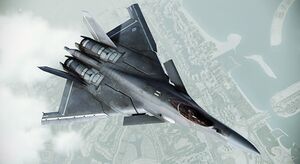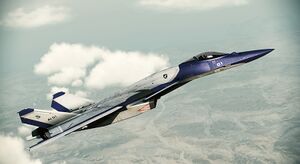AFASF-14 Aquilone Air Superiority Fighter
| Ersilia AFASF-14 Aquilon | |
|---|---|

| |
| An Aquilone flying over Fumicino in 2017. | |
| Role | Stealth air superiority fighter |
| National origin | |
| Manufacturer | Ersilia Defense and Aeronautics |
| First flight | 3 August 2010 |
| Introduction | 23 November 2015 |
| Status | In active service |
| Primary user | |
| Produced | 2015—Present |
| Number built | 13 (3 prototypes and 10 operational aircraft) |
| Program cost | ɫ75.5 billion |
| Unit cost |
ɫ198,430,000
|
The Ersilia AFASF-14 Aquilone (Kite) is a single-seat, twin-engine, all weather delta wing stealth fighter aircraft developed by Ersilia Defense and Aeronautics for the Royal Air Fleet. The airframe is a result of the Ossorian-Cacertian Joint Next Generation Fighter program, which also resulted in Ossoria’s F-39 Raven. The final developments were completed through the Royal Air Fleet’s Special Strike Fighter (SSF) project.
The Aquilone is capable of carrying a wide array of weaponry and performing the roles of ground attack, electronic warfare, as well as signal intelligence despite originally being designed primarily for the role of air superiority fighter. Ersilia D&A is currently the only manufacturer and is responsible for the construction of most of the airframe, weapon systems, and final assembly; the aircraft engines are produced by the Casati Aircraft Corporation.
The Aquilone’s combination of stealth, performance, and inherent situational awareness makes it nearly unmatched by any known or currently projected fighter. Due to a lack of clear air-to-air missions, a ban on exports, extremely high cost, and the development of cheaper and more multi-mission aircraft such as the AFASF-13 and NSF-14, the Aquilone has only been produced in a limited run. The RAF, however, considers the AFASF-14 as a critical component to Cacerta’s tactical air power in the region.
Development
The AFASF-14 project was a result of the technological advances produced during the design and development of both the Wyvern and Colibri projects. While the Wyvern is planned to become the Kingdom's main air superiority fighter through the next several decades, a special team of engineers of Ersilia D&A was created to expand on the program with the objective of creating an aircraft that would also be capable of of fulfilling stealth, multirole missions. The expanded design team—designated Project 14 and abbreviated to P-14—was expected to incorporate and take advantage of composite materials, lightweight alloys, advanced flight control systems, new generation stealth technology, and powerful propulsion systems. Development of the project began in 1993 and eventually culminated with a successful prototype making its first flight in 2010.
Ban on Exports
The AFASF-14 was banned for export by Cacertian law as the technologies incorporated in its design are considered state secrets. Despite the ban, however, Cacerta’s Ministry of Defense still included a report regarding the possible costs and feasibility of an export variant of the AFASF-14 as well as an additional report on the effects of Aquilone export sales on the Cacertian aerospace industry should the ban be lifted in the future.
Design
The AFASF-14 is a fifth-generation fighter and is the first Cacertian aircraft to combine stealth, supercruise, supermaneuverability, sensor fusion, and multi-mission weapon systems in a single platform. The Aquilone is a modified delta wing aircraft with control surfaces including canards, leading-edge flaps, flaperons, ailerons, and rudders on canted vertical stabilizers. It is also equipped with retractable tricycle landing gear.
The aircraft is powered by two closely spaced Casati 14-13 afterburning turbojets that each incorporate a trio of thrust-vectoring paddles that provide it with extremely high maneuverability at the expense of flight stability. Maximum speed without external stores is estimated to be Mach 1.82 while supercruising and greater than Mach 2 with afterburners.
The Aquilone is the second Cacertian aircraft with the capability to supercruise, a technology that was first pioneered by Ersilia D&A in the production of the Wyvern. Compared to its predecessor, however, the AFASF-14 has far superior and fuel-efficient afterburners that allow it to sustain supersonic flight for longer periods of time. It's use of internal weapons bays also allows the Aquilone to maintain a comparatively higher performance to aircraft that use external hardpoints which result in higher drag.
AFASF-14 possesses three internal weapon bays: one along the bottom of the fuselage and two on top just aft of the cockpit. These internal bays are capable of being outfitted with a variety of air-to-air and air-to-ground weaponry, allowing the Aquilone to be equipped for a number of differing missions. Two 20 mm cannons are internally mounted, embedded in both the left and right wing roots.
Production
The AFASF-14 is the most expensive and most advanced single-seat fighter ever to be produced in the Kingdom. Due to its cost and the time required to perfect its systems, production of the Aquilone is characteristically slow. It has not entered serialized production.
Production Figures
Since the creation of the first prototypes, ten operational Aquilone fighters have been built. Many of these remain in the Kingdom's experimental reserve with the prototypes used as technology demonstrators.
Operational History
Introduced in 2013, the Aquilone underwent its first operational mission during the Nalayan Civil War conducting high altitude stealth reconnaissance.
Specifications
General Characteristics
- Crew: 1
- Length: 20.4 m (66 ft 11 in)
- Wingspan: 12.4 m (40 ft 8 in)
- Height: 4.0 m (13 ft 1 in)
- Wing Area: 78.0 m² (840 ft²)
- Empty Weight: 19,700 kg (43,340 lbs)
- Loaded Weight: 29,300 kg (64,460 lbs)
- Max Takeoff Weight: 38,000 kg (83,500 lbs)
- Powerplant: 2 x Cas-AFASF14-13 Turbojets
- Fuel Capacity: 8,200 kg (18,000 lbs)
Performance
- Maximum Speed: Mach 2.25 (2,410 km/h, 1,500 mph) at altitude
- Cruise Speed: 1,960 km/h (1,220 mph)
- Service Ceiling: 20,000 m (>65,000 ft)
- Rate of Climb: 400 m/s (78,740 ft/min)
- Wing Loading: 375 kg/m² (77 lb/ft²)
- Thrust/Weight: 1.09
Armament
- Guns: 2 x 20 mm cannons with 660 rounds
- Payload: 10,890 kg (24,000 lb) on 12 internal hardpoints (3 internal vertical weapon bays, two over and one under)


